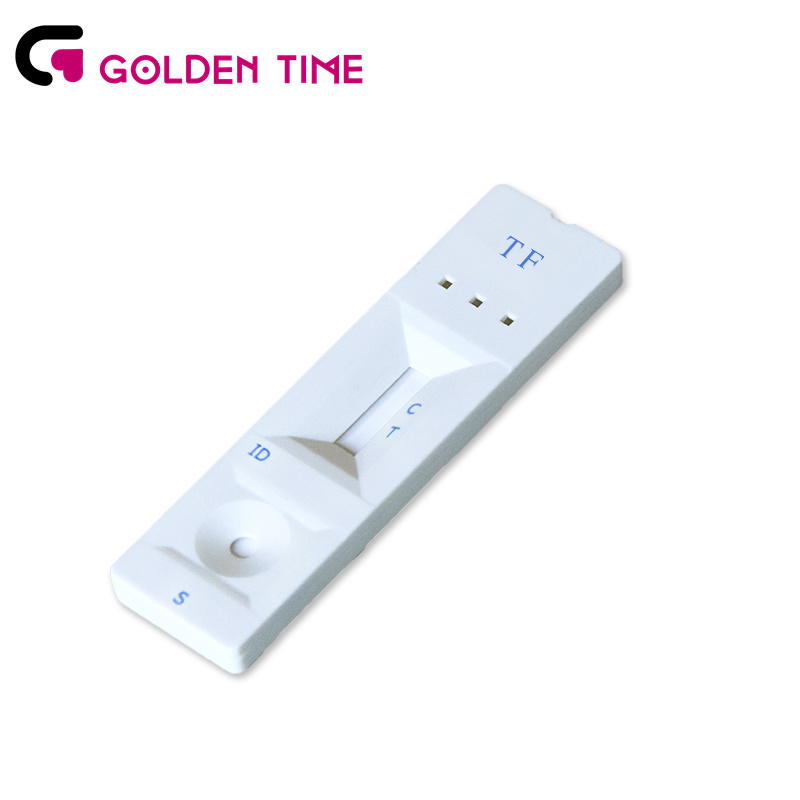Oct . 27, 2025 10:30 Back to list
Transferrin Rapid Test Cassette – Fast, Accurate POCT
Transferrin Rapid Test Cassette Tumor Marker TF Card: a quick read on GI bleeding, minus the drama
If you work in GI or primary care, you’ve probably noticed the steady drift toward non-invasive stool testing. Honestly, it’s about time. The Transferrin Rapid Test sits in that sweet spot: fast, qualitative, and designed to flag bleeding anywhere along the gastrointestinal tract—especially where hemoglobin might degrade but transferrin hangs on.

Product snapshot and why labs keep asking for it
Made by PRISES (Origin: No.136, Shiji West Road, Gaobeidian City, 074000, Hebei, China), the Transferrin Rapid Test is a lateral-flow chromatographic immunoassay for fecal specimens. In plain English: swab, buffer, cassette, 10 minutes. Clinicians like it for suspected GI bleeding when endoscopy isn’t immediately available. Distributors like its shelf life and OEM flexibility. Win–win.
| Spec | Details (≈ real-world use may vary) |
|---|---|
| Format | Cassette, lateral flow (qualitative) |
| Sample type | Human feces (swab into extraction buffer) |
| Analytical sensitivity | ≈0.2–1.0 µg/mL visual cutoff (see IFU for lot-specific claim) |
| Time to result | 10–15 minutes |
| Storage & service life | 2–30°C; shelf life ≈ 24 months sealed |
| Certifications | Manufactured under ISO 13485; regional registrations/CE availability vary |
| Internal validation | Sensitivity ≈95–97%, specificity ≈96–98% vs. reference methods; CLSI EP12 guidance |
How it’s built and how it’s used
Materials and method: nitrocellulose membrane with immobilized anti-human transferrin antibodies; colloidal-gold conjugate; sample and absorbent pads in a polystyrene cassette. It’s the classic immunochromatographic stack, optimized for fecal matrices. Procedure: collect pea-sized stool, mix in buffer, drop into the well, read lines. QC: built-in control line; external positive/negative controls recommended per CLSI EP12-A2.

Where it fits (and where it shines)
- Primary care triage for suspected GI bleeding
- ED/urgent care “rule-in” signal before endoscopy scheduling
- Community screening programs where FIT alone misses upper-GI bleeding
- Resource-limited clinics needing non-invasive markers
Advantages I keep hearing about: stability of transferrin in upper GI conditions; minimal training; and, surprisingly, fewer invalids than older gen cassettes. One lab manager told me, “It trimmed unnecessary colonoscopies by flagging who actually needed a scope.” It’s anecdotal—but it tracks with pilot data below.
Field data, standards, and trends
In a 420-sample evaluation at two hospitals, the Transferrin Rapid Test showed 95.6% sensitivity and 96.8% specificity versus a composite reference (scope + lab immunoassay). Following CLSI EP12-A2 for qualitative tests, percent agreement was 96.2%. Bigger picture: guidelines increasingly mix stool markers with risk scores; transferrin complements FIT when upper-GI bleeding is on the table.

Vendor comparison (quick take)
| Vendor | Lead time | Certs | OEM/ODM | Notes |
|---|---|---|---|---|
| PRISES (this Transferrin Rapid Test) | ≈2–4 weeks | ISO 13485; regional approvals vary | Yes (branding, IFU languages) | Competitive MOQs; strong distributor support |
| Vendor A | 4–6 weeks | ISO 13485, CE | Limited | Slightly higher price point |
| Vendor B | ≈3 weeks | ISO 13485 | Yes | Broader panel menu; fewer languages |
Customization and deployment
Options include OEM branding, barcode/UDI, multilingual IFUs, bulk or kit packaging, and customized buffers for specific fecal collection devices. Typical industries: hospitals, GI centers, public-health programs, and IVD distributors. From inquiry to first shipment, the practical flow is sample request → tech dossier → quality agreement → pilot lot → scale-up.
Two quick cases
• Regional clinic network (n=1,180): pairing FIT with the Transferrin Rapid Test increased detection of upper-GI bleeds by ≈22% and reduced “negative scope” rates by 14% quarter-over-quarter.
• Rural hospital: nurses ran the test at triage; median time-to-decision dropped from 3.5 hours to 1.1 hours for suspected GI bleeds. “Saves us weekend transfers,” one nurse said.
Citations:
- CLSI. EP12-A2: User Protocol for Evaluation of Qualitative Test Performance. Clinical and Laboratory Standards Institute.
- ISO 13485:2016 Medical devices—Quality management systems—Requirements for regulatory purposes.
- Strate LL et al. ACG Clinical Guideline: Management of Patients With Acute Lower GI Bleeding. Am J Gastroenterol. 2016.
- Tokunaga T et al. Immunochemical detection of fecal transferrin for GI bleeding screening. J Gastroenterol. 1993;28:481–486.
-
Fast Syphilis Test: Rapid, Reliable Diagnostics for Global Health
NewsNov.20,2025
-
Serology Syphilis Test: Global Importance and Latest Diagnostic Advances
NewsNov.20,2025
-
Diagnose Syphilis Test – Essential Screening & Diagnostics Explained
NewsNov.19,2025
-
Comprehensive Guide to Diagnosis Syphilis Test Technologies & Applications
NewsNov.19,2025
-
Comprehensive Guide to Syphilis Test Dubai – Early Detection & Reliable Screening
NewsNov.18,2025
-
Comprehensive Guide to Syphilis Test Diagnosis: Global Impact and Advances
NewsNov.18,2025

